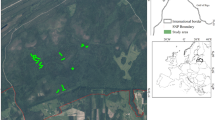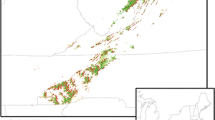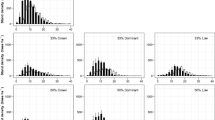Abstract
The decline of red spruce (Picea rubens Sarg.) in montane forests of the northeastern United States has been previously reported. The objective of this study was to assess spatial patterns, if any, in standing dead red spruce stems in the Adirondacks of New York and northern Appalachians of Vermont, New Hampshire, and Maine. A stratified random sample of 19 mountains along a west to east transect in the Adirondacks and the northern Appalachians showed that the live basal area of all species was highest in the White Mountains (34.6 m2 ha−1) and lowest in the Adirondack Mountains (23.7 m2 ha−1) in the Green Mountains was significantly lower than in any other region. Intact standing dead red spruce in the Adirondack and Green Mountains (30%) was significantly higher than that in the three eastern clusters (14%). The amount of intact standing dead red spruce trees increased with elevation in only the western part of the region. With the exception of the Adirondacks, there was a greater average percent dead red spruce on the west side than on the east side of each mountain. The sum of standing dead for other tree species (average 13%) showed no statistically significant patterns with region, elevation or aspect, and was significantly lower than the amount of total dead red spruce (average 42%). The standing dead red spruce patterns we observed cannot be associated with any specific causal factors at this time.
Similar content being viewed by others
Explore related subjects
Discover the latest articles and news from researchers in related subjects, suggested using machine learning.References
Christensen, O.: 1977, ‘Estimation of Standing Crop and Turnover of Dead Wood in a Danish Oak Forest’, Oikos 28, 177–186.
Cogbill, C. V.: 1976, ‘The History and Character of Acid Precipitation in Eastern North America’, Water Air and Soil Pollut. 6, 407–413.
Cogbill, C. V. and Likens, G. E.: 1974, ‘Acid Precipitation in the Northeastern United States’, Water Resources Res. 10, 1133–1137.
Eckert, R. T.: 1989, ‘Genetic Variation in Red Spruce and its Relation to forest Decline in the Northeastern United States’, in J. B. Bucher and I. Bucher-Wallin (eds.), Air Pollution and Forest Decline, Proc. 14th Int. Meeting for Specialists in Air Pollution Effects on Forest Ecosystems, IUFRO P2.05, Interlaken Switzerland, Oct. 2–8, 1988, pp. 319–324.
Fahey, T.J. and Lang, G.E.: 1975, ‘Concrete Frost along an Elevational Gradient in New Hampshire’, Can. J. For. Res. 5, 700–705.
Foster, J. R. and Reiners, W. A.: 1983, ‘Vegetation Patterns in a Virgin Subalpine Forest at Crawford Notch, White Mountains, New Hampshire’, Bull. Torrey Bot. Club 110, 141–153.
Franklin, J. F.: 1987, ‘Importance and Justification of Long Term Studies in Ecology’, in G. E., Likens (ed.), Long-Term Studies in Ecology, Approaches and Alternatives, Springer-Verlag, New York, pp. 3–19.
Freeman, D. H.Jr., 1987, Applied Categorical Data Analysis, Marcel Dekker, Inc. New York, 318 pp.
Friedland, A. J., Johnson, A. H., and Siccama, T. G.: 1984a, ‘Trace Metal Content of the Forest Floor in the Green Mountains of Vermont: Spatial and Temporal Patterns’, Water, Air, and Soil Pollut., 21, 161–170.
Friedland, A. J., Gregory, R. A., Kärenlampi, L., and Johnson, A. H.: 1984b, ‘Winter Damage to Foliage as a Factor in Red Spruce Decline’, Can. J. For. Res. 14, 963–965.
Grier, C. C.: 1978, ‘A Tsuga Heterophylla — Picea Sitchensis of Coastal Oregon: Decomposition and Nutrient Balances of Fallen Logs’, Can J. For. Res. 8, 198–206.
Harmon, M. E.: 1982, ‘Decomposition of Standing Dead Trees in the Southern Appalachian Mountains’, Oecologia 52, 214–215.
Holway, J. G. and Scott, J. T.: 1969, ‘Vegetation-Environment Relations at Whiteface Mountain in the Adirondacks’, Publication No. 92, Atmospheric Sciences Research Center, SUNY-Albany, NY.
Hornbeck, J. W. and Smith, R. B.: 1985, ‘Documentation of Red Spruce Growth Decline’, Can. J. For. Res. 15, 1199–1201.
Iles, K. and Fall, M.: 1988, ‘Can an Angle Gauge Really Evaluate “Borderline Trees” Accurately in Variable Plot Sampling?’, Can. J. For. Res. 18,774–781.
Johnson, A. H. and Siccama, T. G.: 1983, ‘Acid Deposition and Forest Decline’, Environ. Sci. and Technology 17, 294a–305a.
Johnson, A. H. and McLaughlin, S. B.: 1986, ‘The Nature and Timing of the Deteriation of Red Spruce in the Northern Appalachians’, Report of the Committee on Monitoring and Trends in Acidic Deposition, National Research Council, U.S. National Academy Press, Washington, D.C., pp. 200–230.
Johnson, A. H., Cook, E. R., and Siccama, T. G.: 1988, ‘Climate and Red Spruce Growth and Decline in the Northern Appalachians’, Proc. Natl. Acad. Sci. U.S.A. 85, 5369–5373.
Lambert, R. L., Lang, G. E., and Reiners, W. A.: 1980, ‘Loss of Mass and Chemical Change in Decaying Boles of a Subalpine Balsam Fir Forest’, Ecology 61 (6), 1460–1473.
Lovett, G. M., Reiners, W. A., and Olson, R. K.: 1982, ‘Cloud Droplet Deposition in Subalpine Balsam Fir Forests’, Science 218, 1303–1304.
McNulty, S. G., Aber, J. D., McLellan, T. M., and Katt, S. M.: 1990, ‘Nitrogen Cycling in High Elevation Forests of the Northeatern US in Relation to Nitrogen Deposition’, Ambio 19, 38–40.
Mohnen, V.: 1987, ‘Mountain Cloud Chemistry Project Wet, Dry and Cloud Water Deposition’, Report to Ralph Baumgardner, US EPA, Research Triangle Park, N.C. CR 813934-01-2, 77 pp.
Oosting, H. J. and Billings, W. D.: 1951, ‘A Comparison of Virgin Spruce-Fir Forests in the Northern and Southern Appalachian System’, Ecology 32, 84–103.
Reiners, W. A., Hollinger, D. Y., and Lang, G. E.: 1984, ‘Temperature and Evapotranspiration Gradients of the White Mountains, New Hampshire, U.S.A.’, Arctic and Alpine Res. 16, 31–36.
Rizzo, D. M. and Harrington, T. C.: 1988, ‘Root Movement and Root Damage of Red Spruce and Balsam Fir of Subalpine Sites in the White Mountains, New Hampshire’, Can. J. For. Res. 18, 991–1001.
Sabo, S. R.: 1980, ‘Niche and Habitat Relations in Subalpine Bird Communities of the White Mountains of New Hampshire’, Ecol. Monogr. 50, 241–259.
SAS Institute Inc.: 1985, SAS User's Guide: Statistics Version 5 Edition. Cary, North Carolina. p. 171–255.
Schwartz, S. E.: 1989, ‘Acid Deposition: Unravelling a Regional Phenomenon’, Science 243, 753–763.
Scott, J. T., Siccama, T. G., Johnson, A. H., and Breisch, A. R.: 1984, ‘Decline of Red Spruce in the Adirondacks, New York’, Bull. Torrey Bot. Club 111, 438–444.
Siccama, T. G.: 1974, ‘Vegetation, Soil, and Climate on the Green Mountains of Vermont’, Ecol. Mon. 44, 325–349.
Siccama, T. G., Bliss, M., and Vogelmann, H. W.: 1982, ‘Decline of Red Spruce in the Green Mountains of Vermont’, Bull. Torrey Bot. Club 109, 162–168.
Spurr, S. H. and Barnes, B. V.: 1980, Forest Ecology, 3rd ed., John Wiley and Sons, New York, 687 p.
Weiss, M. J., McCreery, L. R., Millers, I., Miller-Weeks, M., and O'Brien, J. T.: 1985, ‘Red Spruce and Balsam Fir Decline and Mortality in New York, Vermont and New Hampshire 1984’, USDA Forest Service Northeastern Area NA-TP-11.
Zemba, S. G., Golomb, D., and Fay, J. A.: 1988, ‘Wet Sulfate and Nitrate Deposition Patterns in Eastern North America’, Atmos. Environ. 22, 2751–2761.
Author information
Authors and Affiliations
Rights and permissions
About this article
Cite this article
Craig, B.W., Friedland, A.J. Spatial patterns in forest composition and standing dead red spruce in montane forests of the Adirondacks and northern Appalachians. Environ Monit Assess 18, 129–143 (1991). https://doi.org/10.1007/BF00394975
Received:
Issue Date:
DOI: https://doi.org/10.1007/BF00394975




